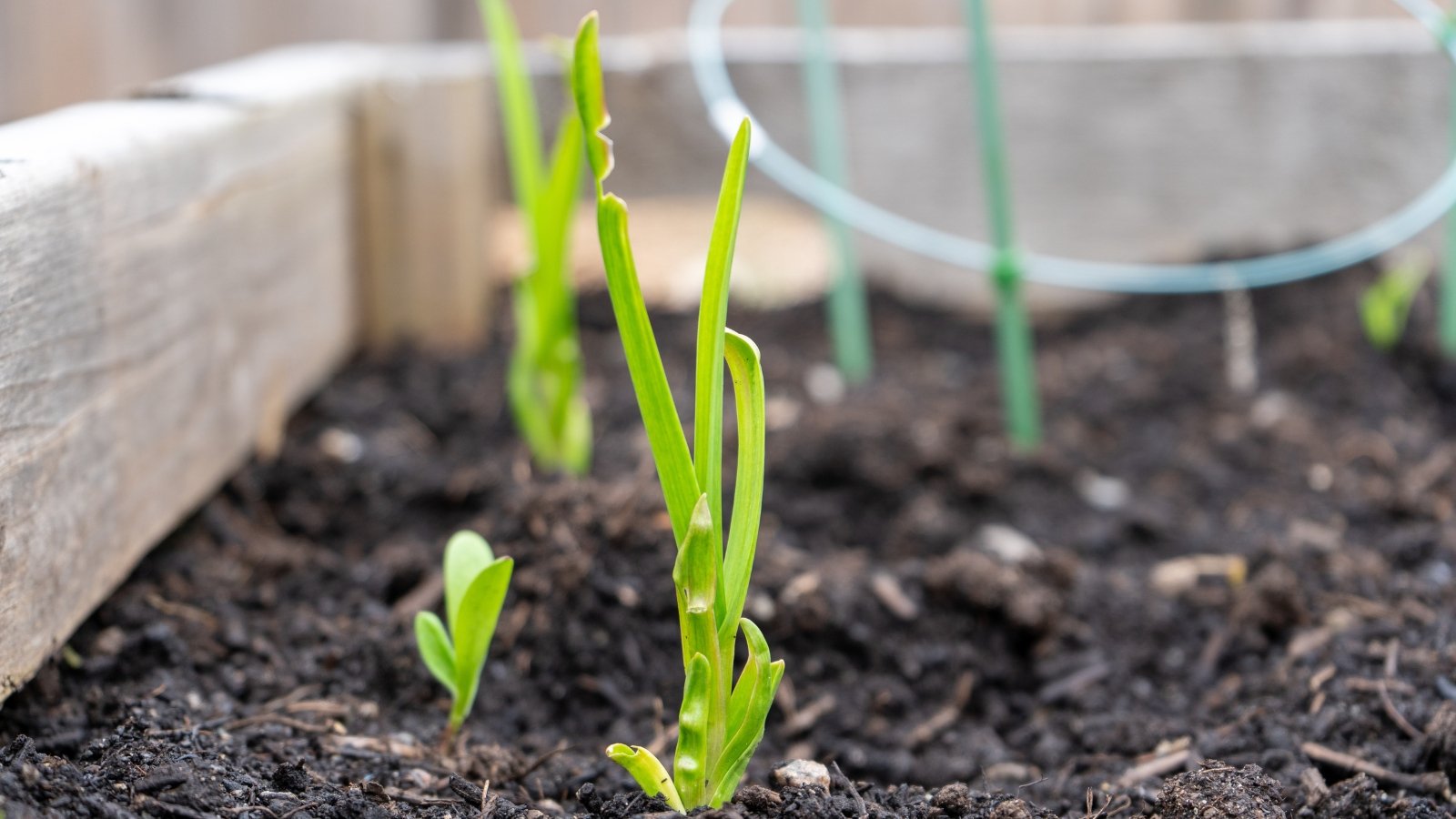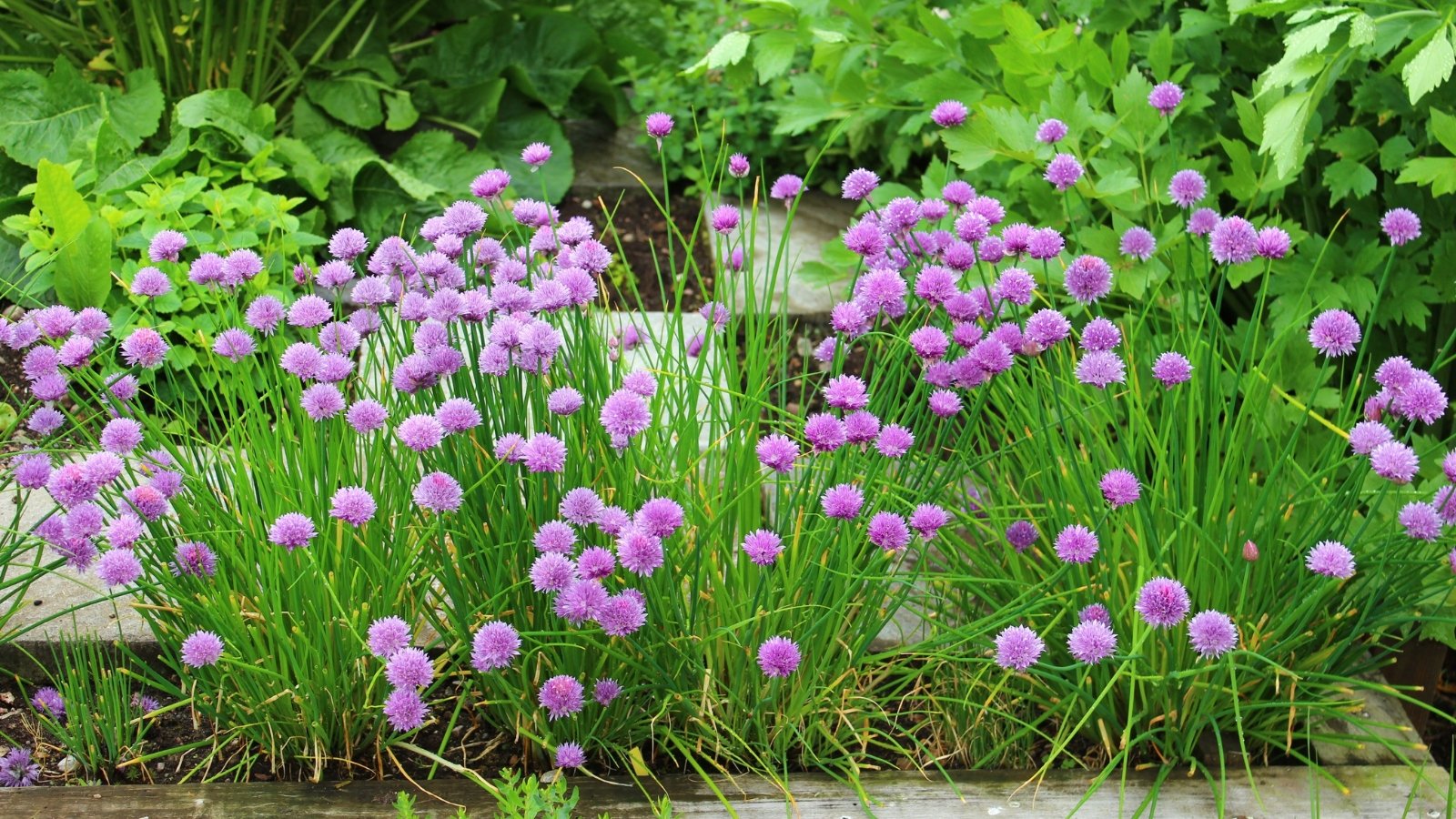When to Plant Allium Bulbs
Alliums bring high color, structure, and reliable style to the perennial border and planter. Their stately globe-shaped florets complement any garden style. Join gardening expert Katherine Rowe in how to plant these sculptural, pollinator-attracting blooms this fall for a late spring display.

Contents
Alliums feature an array of species that offer ornamental value. From giant alliums with their globes of starry purple to compact perennials with pompon flowers, they’re at home in the border. However, when you plant allium bulbs can dramatically impact their performance.
Related to onions, leeks, and chives, ornamental varieties feature bladed leaves and spheres of star-shaped florets on tall stems. Grown for their form rather than flavor, ornamental alliums offer reliable flowering with sculptural impact. Pollinators flock to the showy globes in late spring and early summer.
The architectural beauties are easy-to-grow perennials. Plant the bulbs in the fall to enjoy their display as temperatures warm. Weave them into the perennial arrangement with other flowering bulbs and early summer bloomers to span the seasons.
Our Favorites
Allium Overview

There are over 700 species of Allium, and their family, Amaryllidaceae, includes agapanthus, amaryllis, daffodils, garlic, onions, leeks, and many others. Ornamental alliums bridge spring and summer in various bloom sizes and colors in blue, pink, purple, white, and yellow.
Their dramatic flower clusters emerge as spheres in spring and early summer. They bring high form blended with whimsy. Giant ornamental onions produce towering rounds that average three to five feet tall, depending on the variety. Others are more compact and fit a range of garden spaces with a profusion of little globes.
With their highly decorative flower heads, they’re exceptional in groups. Alliums pair beautifully with contrasting foliage like yarrow, nepeta, and artemisia, which add softness. Daylilies and grasses add sway and movement. Colorful geraniums anchor the base of plants. Peonies and irises offer blooming color.
The perennial bulbs are low-maintenance, easy-care, and drought-tolerant. They perform best in full sun. They have few landscape problems and resist deer, rabbits, pests, and diseases. The flowers don’t have an oniony fragrance, but, as members of the onion family, bulbs and leaves have a garlicky onion scent as repellant qualities. The scent is most noticeable when leaves are bruised, crushed, or clipped.
Some cultivars, like ‘Millennium’ and ‘Summer Beauty,’ are herbaceous perennials. They form robust root systems and spread through rhizomes rather than bulbs and offsets.
Alliums prefer mild, cool climates and tolerate winters across zones 4 or 5 to 8. They grow in various soils with excellent drainage. Their native Western and Central Asian soils are sandy, dry, and well-draining.
When To Plant Allium Bulbs

Fall is the best time to plant ornamental alliums. September, October, and November are prime for planting, while December and January are best for warmer climates. Tuck them in as you plant other spring-flowering bulbs like daffodils and tulips and await the spring display.
The bloomers grow well as container features, too, with sizing dependent on the mature growth of the variety and number of plants per pot.
Prepare the Site

Good soil drainage is a primary factor in healthy growth and flowering. Alliums tolerate various soil types, from loamy to sand to clay, as long as they drain well. Ideal soils are slightly acidic, with a pH near 5.5 to 6.5, but they’ll grow in acidic, neutral, or alkaline soils.
For sites with poor soils like clay and sand, generously add composted organic material to the native soil to improve aeration, moisture retention, drainage, and nutrition. Spread a generous layer over the entire area at fall planting to provide insulation and soil improvement as they enter dormancy below ground.
For potted bulbs, provide a quality potting mixture and appropriate light conditions. Potting mix rather than garden soil is essential, as alliums need loose, lightweight, well-draining soils to thrive in containers. Topdress with compost for added nutrition.
Site giant ornamental onions in an area protected from high winds. A strong gust can topple tall bloomscapes. If strong winds are likely, stake stems as a precaution.
How to Plant

A good rule of thumb is to plant allium bulbs in holes two to three times their size. Dig a hole two to three times the bulb’s diameter, roughly four to eight inches deep for giant types and less for smaller ones (giant allium bulbs are large at two to three inches across).
Determine the proper spacing according to size and variety, usually 6 to 8 inches apart for average growers and 8 to 12 inches apart for giant ones. This spacing creates a dense floral display for grouped planting.
Plant them flat-end down and pointy (stem) end up. This way, the stems and roots won’t have to work harder to reach the sun or absorb moisture and nutrients. They’ll usually find their way up, though.
Water after planting, but avoid regular irrigation. Overly saturated soils lead to bulb rot during dormancy. Average fall and winter seasonal moisture is sufficient for dormant alliums.
Divide and Transplant

In addition to planting, fall is optimal for dividing and transplanting allium bulbs, allowing roots to develop before freezing conditions. They propagate easily through division, and they’ll benefit from reduced crowding. It also lets us expand the collection into other garden areas.
Opt for fall division if you notice groups becoming overcrowded with less flowering and vigor. After foliage fades in late summer and early fall, dig, split, and replant. This division will rejuvenate the crop.
Dividing alliums is easy and straightforward. Here are steps for best practices:
- In the fall, lift them with a fork or spade and peel off any offsets (bulblets) from the main bulb.
- Replant the mother bulb.
- Choose a spot with full sun and good drainage for the new alliums and plant according to variety spacing and size guidelines.
- Water deeply for evenly moist soil.
- Let them be and enjoy the expanded collection as blooms appear in spring.
Post-Bloom Care

After planting and establishing allium bulbs, these carefree and unfussy perennials have low maintenance requirements—so low that leaving foliage in place post-flowering promotes health and vigor for perennialization.
When they flower, the foliage lays flat at the plant’s base. Leaves begin to yellow, wither, and fade as the plant uses energy to bloom. To conceal fading foliage, use other plants as a foil. Allow leaves to turn yellow and fade naturally before plucking or cutting them. They’ll continue to supply energy to the bulbs for storage, which is essential for successful overwintering and continued flowering.
Enjoy fresh or dried flower umbels in floral arrangements, or allow flowers to remain on the stem for continued seasonal interest. They’re showy when florets dry and seed capsules emerge.
Overwinter container-grown plantings in place or provide a protected location by nestling them in a group or against a wall with a layer of leaves. For best success in the lowest hardiness zones, overwinter pots in an unheated garage or basement.
Popular Varieties

The sculptural blooms “wow” garden visitors with impressive sizes and rich colors. They bring a burst of color in uniform lollipop clusters.
‘Globemaster’

|
|
common name ‘Globemaster’ |
|---|---|
|
|
botanical name Allium ‘Globemaster’ |
|
|
sun requirements Full sun |
|
|
height 20-30” |
|
|
hardiness zones 5-8 |
‘Globemaster’ is a hallmark of the giants with spheres of purple florets that measure 10 inches across. Stout stems hold the impressive globes upright for their May display.
Densely-packed deep lavender florets have a silvery sheen. As each fades, a new floret replaces it for an extended bloom time. After flowering, the petals dry and turn tawny for lasting interest into summer.
‘Globemaster’ is a sterile variety, so reseeding isn’t an issue. The outstanding performer is an RHS Award of Garden Merit recipient.
‘Powder Puff’

|
|
common name ‘Powder Puff’ |
|---|---|
|
|
botanical name Allium ‘Powder Puff’ |
|
|
sun requirements Full sun |
|
|
height 14-18” |
|
|
hardiness zones 4-8 |
‘Powder Puff’ features the high ornament of purple-floret spheres in a more compact, cold-hardy form. This ornamental onion bears deep purple, tennis-ball-sized blooms in late spring and early summer for the border or container display.
Pollinators and other beneficial insects flock to the vibrant flowers. It’s easy to plant these prolific bloomers as single specimens and leave them until the spring show. Provide extra winter mulch in lower hardiness zones.
‘Mount Everest’

|
|
common name ‘Mount Everest’ |
|---|---|
|
|
botanical name Allium ‘Mount Everest’ |
|
|
sun requirements Full sun |
|
|
height 2-3’ |
|
|
hardiness zones 4-8 |
‘Mount Everest’ is a giant ornamental that stands tall with creamy white flowers and lime green eyes. The snow-capped blooms top sturdy stems with statuesque globes.
The tightly formed spheres beautifully contrast violet varieties for a blend of cool tones. ‘Mount Everest’ is perfect for a white-themed garden display or to complement colorful bloomers and foliage as a mid-border specimen.
‘Purple Sensation’

|
|
common name ‘Purple Sensation’ |
|---|---|
|
|
botanical name Allium hollandicum ‘Purple Sensation’ |
|
|
sun requirements Full sun |
|
|
height 24-36” |
|
|
hardiness zones 4-9 |
‘Purple Sensation’ is popular for its velvety royal purple four- to five-inch spheres that last for weeks of color. This is one of the earliest blooming of the large-flowered varieties, and honeybees appreciate its sweet nectar.
As a smaller, more compact variety, it’s versatile in garden beds and planters. Its foliage is attractive and silvery (before it declines during flowering) and is still best tucked among perennials.
‘Gladiator’

|
|
common name ‘Gladiator’ |
|---|---|
|
|
botanical name Allium ‘Gladiator’ |
|
|
sun requirements Full sun |
|
|
height 3-4’ |
|
|
hardiness zones 4-8 |
‘Gladiator’ boasts large, lavender-blue florets that reach six inches across. One of the tallest, along with ‘Globemaster,’ strong scapes rise above other bloomers and contrast them in form.
Flowers have a sweet scent that draws pollinators. Plant them in a mass for a majestic show of color. ‘Gladiator’ is a Royal Horticultural Society Award of Garden Merit recipient.
Frequently Asked Questions
I missed fall planting. Can I plant alliums in the spring?
Fall-planted allium bulbs show the best growth and flowering. Planting at the wrong time of year may cause a lack of root development, less vigorous plants, and poor flowering. Herbaceous hybrids like ‘Millenium’ that spread through rhizomes can be spring planted. You can also purchase nursery-started plants in the spring. Divide and transplant bulbs in spring if you missed it in fall. New transplants or greenhouse-started spring plantings may flower in the same season.
What plants pair well with alliums?
The bulbous perennials bloom for a few weeks in late spring to early summer. After flowering, the dried flowers and seed capsules add lasting interest.
Ornamental alliums complement early-blooming summer perennials like catmint, lady’s mantle, phlox, peonies, and iris. Use these to disguise brown and dying foliage after your alliums bloom.










